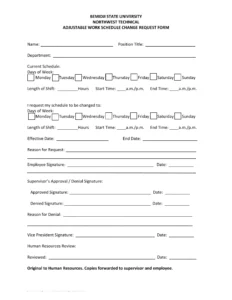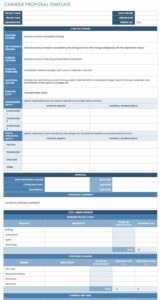Utilizing such a structured approach fosters better control over project evolution. It facilitates informed decision-making by stakeholders, reduces the risk of scope creep, and maintains project transparency. This process allows for proper evaluation of the change’s impact and enables proactive adjustments to project plans, ultimately contributing to a higher likelihood of successful project completion.
This structured approach to managing project adjustments plays a pivotal role in maintaining project integrity and achieving desired outcomes. Further exploration of key elements, best practices, and practical applications will provide a comprehensive understanding of its value in various project contexts.
Key Components of a Scope Change Request
Effective management of project modifications requires a structured approach. The following components ensure clarity and completeness when requesting adjustments to established project parameters.
1: Request Identification: A unique identifier allows for easy tracking and referencing throughout the project lifecycle.
2: Requestor Information: Details about the individual or team initiating the change request, including their role and contact information.
3: Date of Request: Timestamping provides a clear record of when the change was proposed.
4: Current Scope Description: A concise summary of the currently approved scope relevant to the proposed change.
5: Proposed Change Description: A clear and detailed explanation of the desired modification to the scope. This should include specific deliverables, timelines, or resources affected.
6: Justification/Rationale: A compelling explanation for the necessity of the change, including the benefits it will bring or problems it will solve.
7: Impact Assessment: An analysis of the change’s potential effects on the project’s schedule, budget, and resources. Quantifiable data should be provided whenever possible.
8: Approval Section: Designated spaces for relevant stakeholders to sign off on the proposed change. This section should indicate the approval authority levels required.
These elements ensure that proposed modifications are thoroughly documented, facilitating informed decision-making and contributing to successful project outcomes.
How to Create a Scope Change Request Template
Developing a standardized template for scope change requests promotes consistency and efficiency in managing project modifications. A well-designed template ensures all necessary information is captured, facilitating informed decision-making and minimizing disruptions.
1: Define Required Fields: Begin by identifying the essential information needed to evaluate a scope change request. This typically includes request details, justification, impact assessment, and approval sections. Referencing existing project documentation and industry best practices can inform this process.
2: Structure the Template: Organize the fields logically to facilitate clear communication. Group related information together and use headings and subheadings to improve readability.
3: Use Clear and Concise Language: Employ terminology that is easily understood by all stakeholders. Avoid jargon or technical terms that may create confusion.
4: Incorporate Version Control: Implement a version control system to track revisions to the template. This ensures stakeholders are always using the most up-to-date version.
5: Establish Approval Workflows: Clearly define the approval process for scope change requests within the template. Specify the individuals or roles responsible for reviewing and approving changes.
6: Test and Refine: Pilot the template on a small scale to identify areas for improvement. Gather feedback from users and revise the template as needed.
7: Disseminate and Train: Once finalized, distribute the template to all relevant stakeholders. Provide training on how to complete and submit scope change requests using the template.
A robust template provides a framework for managing project modifications effectively, ensuring consistent evaluation and communication throughout the project lifecycle. This systematic approach reduces the likelihood of misunderstandings and contributes to successful project delivery.
Effective project management necessitates a structured approach to managing inevitable modifications. A standardized scope change request template provides a critical mechanism for documenting, evaluating, and approving alterations to project parameters. Utilizing a well-defined template ensures clear communication, facilitates informed decision-making, and mitigates the risks associated with scope creep and uncontrolled project evolution. Key components of such a template include clear identification, detailed descriptions of proposed changes, justification, impact assessments, and defined approval workflows. Creating and implementing a robust template requires careful consideration of project needs and stakeholder involvement. This structured approach empowers project teams to maintain control, minimize disruptions, and ultimately increase the likelihood of successful project completion.
Proactive implementation of a standardized process for managing scope changes significantly contributes to overall project success. Organizations that embrace this disciplined approach are better equipped to navigate the complexities of project evolution, ensuring alignment with strategic objectives and delivering desired outcomes. Continued refinement of these processes, combined with ongoing stakeholder engagement, will further enhance project management capabilities and drive organizational efficiency. The effective management of change requests stands as a cornerstone of successful project delivery in today’s dynamic environment.


